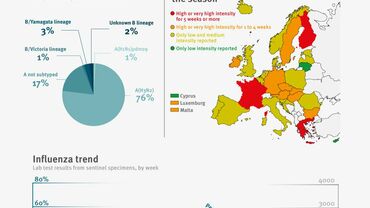Influenza surveillance for the 2017-2018 season is starting
ECDC monitors and reports on influenza transmission and virus circulation in Europe on a weekly basis throughout the flu season, in collaboration with WHO Regional Office for Europe, in the report Flu News Europe. Now the surveillance season is starting.
ECDC monitors and reports on influenza transmission and virus circulation in Europe on a weekly basis throughout the flu season, in collaboration with WHO Regional Office for Europe, in the report Flu News Europe. The weekly monitoring for the European influenza season started last week (data from week 40) and runs until week 20/2018.
As expected, the first reports show low influenza activity in the European region. However, due to the diversity of A(H3N2) influenza viruses that circulated during the 2017 southern hemisphere season, WHO recently recommended a change of the A(H3N2) component for inclusion in seasonal influenza vaccines for use in the 2018 southern hemisphere influenza season. In addition, the influenza B lineage in trivalent vaccines was changed (to a B/Yamagata-lineage virus), compared to the vaccine component (a B/Victoria-lineage virus) recommended for 2017-2018 northern hemisphere influenza seasons (1).
Vaccination is the most effective form of influenza prevention. However, antivirals can be useful when the vaccine is less than optimally effective especially to treat patients with severe influenza or those at high risk of the complications of influenza. A new ECDC infographic explains how antivirals treat and protect against influenza. The recommendations to treat patients with severe influenza are based on the evidence from randomised controlled trials, observational studies, extrapolation from studies, and that these medicines have generally mild side-effects (2).
Influenza is a preventable infectious disease with mostly respiratory symptoms. It is caused by influenza virus and is easily transmitted. Influenza viruses infect on average 18% of unvaccinated people each winter and on average 15 000 - 95 000 people die each year from influenza in EU/EEA countries (3-4). Despite the often short duration of illness, the yearly economic and healthcare burden of influenza is substantial (5).










